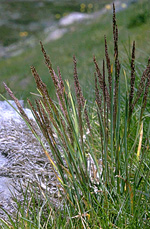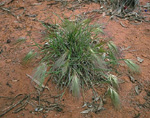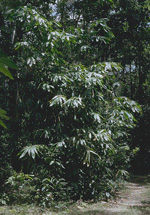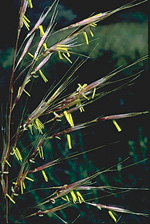 |
This is one of the largest, most widespread and most successful and important families in the world. In Australia, over 1000 native and introduced species may be found anywhere except in the understoreys of rainforests. Grasses are particularly important in drier areas, in the alps and on rich soils. Many species are introduced weeds.
Characteristic features of the family Poaceae in Australia include: - herbs forming clumps or turf (spreading by rhizomes or stolons), a few bamboo species tree-like
- leaves usually linear with parallel veins, alternate and 2-ranked (very rarely spiral), basally sheathing the stem and with a small, membranous flap or ring of hairs at the junction of the blade and sheath
- flowers small, subtended by specialised bracts to form a floret, these aggregated into spikelets which are themselves usually aggregated into higher-order inflorescences
- perianth absent or represented by two small lobes (lodicules) at the base of the superior ovary
- fruit a grain, often enclosed at maturity in the persistent floral bracts
Description
Annual or perennial terrestrial herbs, sometimes evergreen or deciduous
semi-woody shrub-like giant herbs (bamboos), or woody or herbaceous scrambling
vines, or rarely aquatic herbs rooted in the substrate with their leaves
floating or emergent. Perennating by rhizomes, crowns or rarely tubers.
Vegetative reproduction absent or by rhizomes, stolons, rarely tubers
or by detached stem parts, bulbils or proliferous flowerheads. Stems unarmed,
or rarely with thorns or spines arising from the leaf axils; nodes conspicuously
swollen or not; internodes solid, spongy or pithy or hollow, terete or
oval or slightly flattened. Internal secretions not obvious or of resin.
Plants glabrous, or with simple, glandular or non-glandular, unicellular
hairs. Leaves well developed or much reduced (i.e. to scales, etc.), alternate
and spiral or distichous, or if herbs then the leaves cauline, all or
mostly basal, or both basal and cauline, petiolate or sessile. Stipule-like
lobes present or apparently absent. Lamina simple, symmetric, filiform,
acicular, subulate or linear; base attenuate, cordate, hastate, sagittate,
lobed or auriculate; margins entire, ±flat, revolute, recurved,
involute or incurved; venation parallel, rarely pinnate or palmate, with
the midrib conspicuous or inconspicuous, and the tertiary venation reticulate
or not; surfaces punctate or not punctate; herbaceous or leathery; distinctive
odour absent or aromatic. Leaf ligule present or absent. All the flowers
bisexual, or with bisexual flowers occurring together with either male
or female flowers, or both male and female flowers occurring on the same
plant, or either male or female flowers occurring on the same or on separate
plants, rarely apomictic or proliferous. Flowers solitary or in terminal
or axillary inflorescences consisting of solitary flowers or spikelets
apparently arranged in spikes, racemes, panicles or umbels. Spathes present
or absent. 'Bracts' (glumes, lemmas) present; 'bracteoles' (paleas) present
or rarely absent. Pollination by wind. Flowers (florets) odourless; sessile
or apparently stalked. Floral disc absent; nectaries absent. 'Perianth'
vestigial, with (1–) 2 (–3) free segments (lodicules), or absent, papery,
cream, yellow, purple, green, brown or black, with or without contrasting
markings. Fertile stamens 1–3 (–4) or 6, not clearly correlated with and
free of the 'perianth' segments, free of the ovary and style, distinct
from each other, all ±equal. Anthers basifixed, not versatile,
opening outwards, sideways or inwards by pores, short slits or longitudinal
slits; 2-celled. Ovary superior and sessile. Carpels 2, fused; ovary with
1 locule. Style terminal or eccentric, single and branched above or from
the base. Ovule 1, sessile; placentation basal or parietal. Fruit dry
or rarely fleshy, indehiscent; an achene, caryopsis, nut, utricle or berry;
apparent 'perianth' ('bracts' and 'bracteoles') on the maturing fruit
dry and persistent or deciduous. Disseminule macro-surface featureless
or with hairy callus or awned, sometimes with hooked or barbed hairs or
bristles; micro-surface ±smooth, striate or muricate, white, cream,
yellow, orange, green, brown, grey or black, rarely red, glossy or dull.
Seeds 1 per fruit. Aril absent. Cotyledons 1. Embryo straight or sharply
bent.
(Note: this description has been generated from the coded data compiled for the key. Any errors in the key data will be reflected in the descriptions.)
A treatment of the family Poaceae has not yet been published in the Flora of Australia. It will appear in Volumes 43 & 44.
Australian genera of Poaceae (as recognised for the Flora
of Australia)
† = some species native, others introduced
* = all species introduced
*Achnatherum
Acrachne
*Agropyron
†Agrostis
*Aira
Alexfloydia
Alloteropsis
*Alopecurus
*Ammophila
Amphibromus
Amphipogon
Ancistrachne
*Andropogon
Anisopogon
*Anthoxanthum
Apluda
Aristida
*Arrhenatherum
Arthragrostis
Arthraxon
Arundinella
*Arundo
Astrebla
Australopyrum
Austrochloris
Austrodanthonia
Austrofestuca
Austrostipa
*Avellinia
*Avena
*Axonopus
†Bambusa
Bothriochloa
†Brachiaria
Brachyachne
*Brachypodium
*Briza
†Bromus
*Calamagrostis
Calyptochloa
Capillipedium
Catapodium
†Cenchrus
Centotheca
Chamaeraphis
Chionachne
Chionochloa
†Chloris
Chrysopogon
Clausospicula
Cleistochloa
Cliffordiochloa
Coelachne
*Coix
†Cortaderia
Crypsis
†Cymbopogon
Cynochloris
†Cynodon
*Cynosurus
Cyperochloa
Cyrtococcum
*Dactylis
†Dactyloctenium
Dallwatsonia
†Danthonia
Deschampsia
Deyeuxia
†Dichanthium
Dichelachne
†Digitaria
Dimeria
*Dinebra
Distichlis
Dryopoa
†Echinochloa
Echinopogon
Ectrosia
†Ehrharta
*Eleusine
Elionurus
†Elymus
*Elytrigia
Elytrophorus
Enneapogon
Enteropogon
Entolasia
Eragrostiella
†Eragrostis
Eremochloa
*Eremopyrum
Eriachne
†Eriochloa
Eulalia
*Eustachys
†Festuca
Garnotia
*Gastridium
*Gaudinia
Germainia
†Glyceria
*Hainardia
Hemarthria
Heterachne
Heteropogon
Hierochloe
Holcolemma
*Holcus
Homopholis
*Hordeum
Hygrochloa
Hymenachne
†Hyparrhenia
Ichnanthus
Imperata
†Isachne
Ischaemum
Iseilema
*Jarava
Joycea
†Koeleria
*Lagurus
*Lamarckia
†Leersia
Leptaspis
†Leptochloa
Lepturus
*Leymus
*Lolium
Lophatherum
*Melica
*Melinis
*Mibora
Micraira
Microchloa
Microlaena
*Microstegium
*Miscanthus
Mnesithea
Monachather
Monodia
*Nardus
*Nassella
Neurachne
Notochloe
Notodanthonia
Ophiuros
Oplismenus
†Oryza
Ottochloa
Oxychloris
†Panicum
Paractaenum
Paraneurachne
*Parapholis
Paspalidium
†Paspalum
†Pennisetum
Pentapogon
*Pentaschistis
Periballia
Perotis
*Phalaris
Pheidochloa
*Phleum
*Pholiurus
Phragmites
*Phyllostachys
*Piptatherum
*Piptochaetium
Plagiochloa
Plinthanthesis
†Poa
Pogonatherum
†Polypogon
Polytrias
Potamophila
Psammagrostis
Pseudochaetochloa
Pseudopogonatherum
Pseudoraphis
*Psilurus
†Puccinellia
*Rostraria
Rottboellia
Rytidosperma
*Saccharum
Sacciolepis
Sarga
*Schismus
Schizachyrium
*Sclerochloa
Scrotochloa
*Secale
Sehima
†Setaria
Sorghastrum
†Sorghum
*Spartina
Spartochloa
Spathia
*Sphenopus
Spinifex
†Sporobolus
*Steinchisma
†Stenotaphrum
Symplectrodia
*Taeniatherum
Tetrarrhena
Thaumastochloa
Thelepogon
Thellungia
†Themeda
*Thinopyrum
Thuarea
Thyridolepis
Tragus
*Tribolium
Triodia
Tripogon
Triraphis
†Trisetum
*Triticum
Uranthoecium
†Urochloa
Vacoparis
*Vulpia
Walwhalleya
Whiteochloa
Xerochloa
Yakirra
*Zea
Zoysia
Zygochloa

|
  |

Agrostis muelleriana (flowering plant)
Photo: C.Totterdell © ANBG

Aristida behriana (flowering plant)
Photo: S.Donaldson © ANBG

Bambusa forbesii (habit)
Photo: J.Wrigley © ANBG

Chrysopogon fallax (flowers)
Photo: B.Fuhrer © B.Fuhrer

|
 |
|